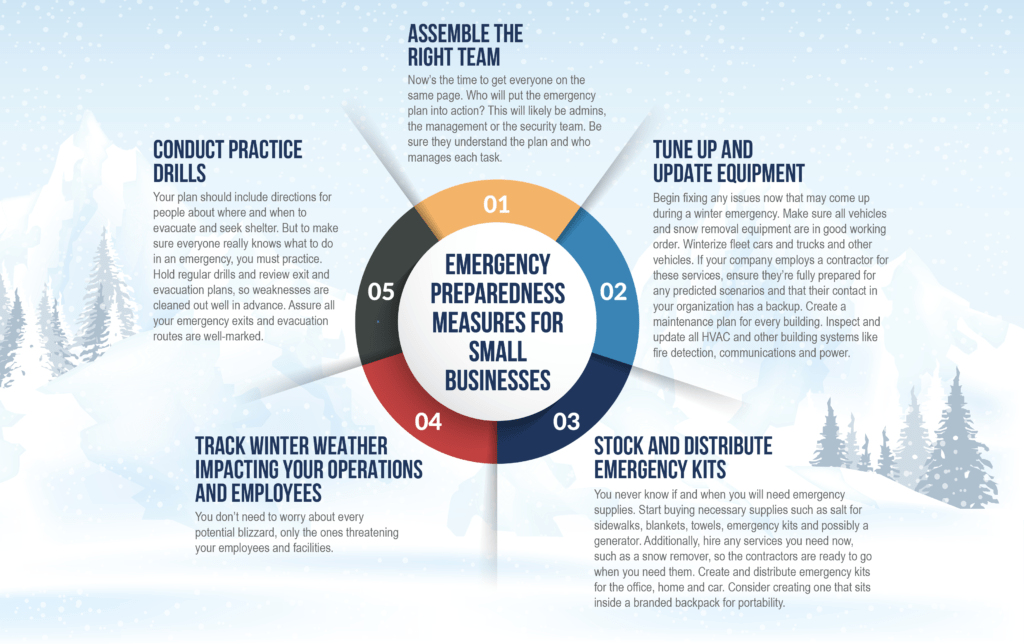Effective Winter Weather Preparation: A Timeline Strategy

Table of Contents
Early Autumn (September - October): Preemptive Planning & Preventative Measures
This initial phase focuses on preventative maintenance and planning to avoid winter weather emergencies. Thorough preparation now minimizes potential problems later.
Home Assessment & Maintenance:
Before the first snowflakes fall, assess your home's vulnerability to winter weather.
- Roof Inspection: Inspect your roof for damage, missing shingles, or potential leaks. Addressing these issues now prevents costly repairs and water damage later. Consider hiring a professional roofer for a thorough inspection.
- Gutter Cleaning: Clean gutters and downspouts to prevent ice dams. Ice dams form when melting snow refreezes, causing water to back up under your roof, leading to leaks and damage.
- Heating System Check: Schedule a professional inspection and maintenance of your heating system. A well-maintained furnace is crucial for staying warm during winter storms and power outages. Replace filters and address any identified issues promptly.
- Essential Supplies: Begin stocking up on essential home supplies. This includes extra blankets, flashlights, batteries, and a first-aid kit (details in the next section).
Vehicle Preparation:
Winterizing your vehicle is vital for safe winter travel.
- Winterization: Check antifreeze levels, ensure your battery is in good condition, and inspect your tires. Consider investing in snow tires for optimal traction in snowy and icy conditions. Replace worn wiper blades for improved visibility.
- Emergency Car Kit: Assemble a comprehensive emergency car kit. This should include jumper cables, a flashlight with extra batteries, blankets, a first-aid kit, non-perishable food, bottled water, and a shovel.
- Basic Car Maintenance: Familiarize yourself with basic car maintenance tasks, such as changing a tire, or consider taking a car maintenance course. This knowledge is invaluable in emergency situations.
- Alternate Routes: Plan alternate routes to your regular destinations in case of road closures due to severe weather. Use navigation apps that provide real-time traffic and weather updates.
Late Autumn (November): Stocking Up & System Checks
November is the time to finalize your emergency preparations and ensure all systems are in order.
Emergency Supply Kit:
Creating a comprehensive emergency kit is paramount for effective winter weather preparation.
- Essential Items: Stockpile flashlights, batteries (consider different sizes), a well-stocked first-aid kit, non-perishable food items (enough for several days), bottled water, warm blankets, extra medications (if needed), hand warmers, and a multi-tool.
- Power Backup: Consider investing in a portable generator to provide power during outages. This is especially important for those reliant on medical equipment or heating systems.
- Fuel Supply: Ensure you have enough fuel for heating your home and for any cooking appliances you might rely on during a power outage.
- Safety Checks: Check smoke detectors and carbon monoxide detectors, replacing batteries as needed. Test them to ensure they are functioning correctly.
Communication Plan:
Maintaining communication is critical during severe weather events.
- Family Contact: Establish a communication plan with family and friends, identifying a central contact person and outlining alternative communication methods (e.g., text messaging, email).
- Emergency Services: Know how to contact emergency services in your area. Consider having alternative methods, like a satellite phone, if you live in a remote area with poor cell service.
- Device Charging: Keep all electronic devices charged and have portable chargers available.
Early Winter (December - January): Seasonal Adjustments & Monitoring
This phase involves adapting your home and routines to the realities of winter weather.
Winterizing Your Home:
Protecting your home from the cold is crucial to prevent costly damage and ensure comfort.
- Pipe Insulation: Insulate exposed pipes and cover exterior faucets to prevent freezing and potential bursts.
- Draft Sealing: Seal any drafts around windows and doors using weather stripping or caulk.
- Water Main Knowledge: Learn how to shut off your home's water main in case of a pipe burst. This can minimize water damage.
- Weather Monitoring: Regularly check weather forecasts and be prepared for potential storms.
Practicing Safety Procedures:
Preparation and practice are key to handling winter emergencies effectively.
- Snow Removal Practice: Practice using your snow shovel and other snow removal equipment before a major snowstorm hits.
- Emergency Response: Familiarize yourself with your local emergency response procedures and evacuation routes.
- Hypothermia/Frostbite Awareness: Learn the signs and symptoms of hypothermia and frostbite and how to respond appropriately.
- Pet Safety: Keep pets indoors during extreme cold weather.
Mid to Late Winter (February - March): Ongoing Maintenance & Adaptability
Even as winter winds down, maintaining vigilance is essential.
Ongoing Monitoring:
Consistent monitoring prevents unexpected problems.
- System Checks: Regularly monitor your home’s heating system and water pipes for any issues.
- Weather Awareness: Keep an eye on weather forecasts and be prepared for unexpected late-season storms.
- Supply Replenishment: Replenish any depleted emergency supplies, ensuring you're ready for any eventuality.
Spring Preparation:
Begin thinking ahead to spring.
- Damage Assessment: Begin planning for spring cleanup and repairs to assess any winter damage to your home and property.
Conclusion:
Effective winter weather preparation is an ongoing process, not a one-time event. By following this timeline strategy and taking proactive steps throughout the fall and winter, you can significantly reduce risks and ensure your safety and comfort. Don't wait until the first snowstorm – start your effective winter weather preparation today! Remember to review and update your plan as needed, ensuring you're always ready for any winter challenge. Proactive winter preparedness means peace of mind.

Featured Posts
-
 Protecting Your Makeup Childproof Storage Options
Apr 25, 2025
Protecting Your Makeup Childproof Storage Options
Apr 25, 2025 -
 Discover Our Great Yorkshire Life A Journey Through History And Culture
Apr 25, 2025
Discover Our Great Yorkshire Life A Journey Through History And Culture
Apr 25, 2025 -
 Refugee Family Finds Hope Pope Francis Role In Their Journey From War
Apr 25, 2025
Refugee Family Finds Hope Pope Francis Role In Their Journey From War
Apr 25, 2025 -
 Understanding Cool Sculpting Complications Lessons From Linda Evangelistas Experience
Apr 25, 2025
Understanding Cool Sculpting Complications Lessons From Linda Evangelistas Experience
Apr 25, 2025 -
 Understanding Wrongful Death Dispelling Persistent Misconceptions
Apr 25, 2025
Understanding Wrongful Death Dispelling Persistent Misconceptions
Apr 25, 2025
Latest Posts
-
 Post 2025 Nhl Trade Deadline A Look At Potential Playoff Matchups
May 10, 2025
Post 2025 Nhl Trade Deadline A Look At Potential Playoff Matchups
May 10, 2025 -
 Nhl Playoff Predictions Post 2025 Trade Deadline
May 10, 2025
Nhl Playoff Predictions Post 2025 Trade Deadline
May 10, 2025 -
 Nhls Hart Trophy Draisaitl Hellebuyck And Kucherov Vie For Top Honors
May 10, 2025
Nhls Hart Trophy Draisaitl Hellebuyck And Kucherov Vie For Top Honors
May 10, 2025 -
 2025 Nhl Trade Deadline Predicting The Playoff Picture
May 10, 2025
2025 Nhl Trade Deadline Predicting The Playoff Picture
May 10, 2025 -
 Hart Trophy Finalists Announced Draisaitl Hellebuyck And Kucherov
May 10, 2025
Hart Trophy Finalists Announced Draisaitl Hellebuyck And Kucherov
May 10, 2025
